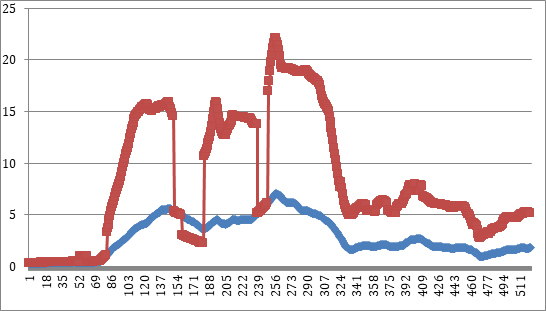Improvement of the methodology for predicting gas-dynamic phenomena on the basis of modern sound-capturing equipment
DOI:
https://doi.org/10.15587/2706-5448.2024.298907Keywords:
gas-dynamic phenomena, acoustic emission, signs of gas-dynamic activity zones, manifestations of mining pressure, prediction of GDPAbstract
The object of the study is the sound accompaniment of the processes of stress redistribution in the bottom part of the coal seam, which precede the release of rock, coal, and gas. Among the hazards of underground coal mining, gas-dynamic phenomena (GDP) are the most complex in nature and the most dangerous in terms of consequences of high dynamic power and the release of a large amount of mechanical energy in the form of fractures and gas in a short period of time. This leads to accidents due to sudden gassing and blockages of workings with coal and rock, as well as explosions of methane and coal dust, destruction of the workings' support, damage to machinery and mechanisms, equipment, and devices. The greatest hazard among GDPs is posed by sudden releases of coal and gas, rock and gas, gas releases with destruction of host rocks and with destruction of the ground of the workings, as well as gas breakthroughs from tectonic fault zones.
Therefore, the accuracy of predicting possible gas-dynamic phenomena significantly affects the level of safety of miners. The acoustic emission (AE) method is used to predict the gas-dynamic activity of a rock massif. The analysis of acoustic emission studies based on archival data in coal seams subject to gas-dynamic activity has made it possible to substantiate the possibility of improving the accuracy of the forecast of emission hazard, which has a social and economic effect. On the basis of exploratory research and production tests, the software for automated calculations of the GDP forecast was improved and an improved Methodology for forecasting gas-dynamic phenomena based on modern sound-capturing equipment was developed. A scientific justification for the reference interval of AE observations in the conditions of a particular longwall was developed.
The developed software and the forecasting methodology were tested in the conditions of the Tsentralna mine of the Toretskugol State Enterprise (Toretsk, Donetsk region, Ukraine). The practical significance of the work is that a method for predicting explosion hazard has been developed, taking into account the modern capabilities of equipment and methods of input data processing, which allows to increase the productivity of mining and tunneling operations in coal seams without reducing the safety of miners.
Supporting Agency
- The research was conducted with the financial support of the Ministry of Energy of Ukraine.
References
- Ettinger, I. L. (1969). Vnezapnye vybrosy uglia i gaza i struktura uglia. Nedra, 160.
- He, M., Wang, Q. (2023). Rock dynamics in deep mining. International Journal of Mining Science and Technology, 33 (9), 1065–1082. doi: https://doi.org/10.1016/j.ijmst.2023.07.006
- Feng, Х. T., Chen, B. G., Ming, H. J., Wu, S. Y., Xiao, Y. X., Feng, G. L. et al. (2012). Evolution law and mechanism of rockbursts in deep tunnels: Immediate rockburst. Chinese Journal of Rock Mechanics and Engineering, 31 (3), 433–444.
- Antciferov, M. S., Konstantinova, A. G., Pereverzev, L. B. (1960). Seismoakusticheskie issledovaniia v ugolnykh shakhtakh. Izd-vo AK Nauk Ukrainy, 103.
- Zhang, J., Wang, M., Zhou, H., Zhang, D., Yu, B., Wang, C., Wang, Y. (2023). Coal and rock dynamic disaster prevention and control technology in the large mining face of a deep outburst mine. Frontiers of Earth Science, 17 (3), 701–712. doi: https://doi.org/10.1007/s11707-022-1060-8
- Li, C. C., Mikula, P., Simser, B., Hebblewhite, B., Joughin, W., Feng, X., Xu, N. (2019). Discussions on rockburst and dynamic ground support in deep mines. Journal of Rock Mechanics and Geotechnical Engineering, 11 (5), 1110–1118. doi: https://doi.org/10.1016/j.jrmge.2019.06.001
- Baranov, V., Antipovich, Y., Stefanko, S. (2023). Frictional phenomena in coal mines: reasons, consequences and influence on gas dynamic and thermal phenomena. Visnyk of Taras Shevchenko National University of Kyiv. Geology, 3 (102), 5–9. doi: https://doi.org/10.17721/1728-2713.102.01
- Baranov, V. A., Pashchenko, P. S., Stefanko, S. V. (2023). Forecast of tectonic disturbances zones in coal layers. Geofizicheskiy Zhurnal, 44 (5), 123–133. doi: https://doi.org/10.24028/gj.v44i5.272332
- Balkhanov, V. K. (2013). Osnovy fraktalnoi geometrii i fraktalnogo ischisleniia. Izdatelstvo BGU, 224.
- Hurst, H. E. (1951). Long-term storage capacity of reservoirs. Transactions of American Society of Civil Engineers, 116, 770–799.
- Hurst, H. E., Black, R. P., Simaika, Y. M. (1965). Long-term storage: an experimental study. Constable. London.

Downloads
Published
How to Cite
Issue
Section
License
Copyright (c) 2024 Vyacheslav Krasnyk, Boris Deglin

This work is licensed under a Creative Commons Attribution 4.0 International License.
The consolidation and conditions for the transfer of copyright (identification of authorship) is carried out in the License Agreement. In particular, the authors reserve the right to the authorship of their manuscript and transfer the first publication of this work to the journal under the terms of the Creative Commons CC BY license. At the same time, they have the right to conclude on their own additional agreements concerning the non-exclusive distribution of the work in the form in which it was published by this journal, but provided that the link to the first publication of the article in this journal is preserved.







